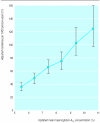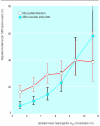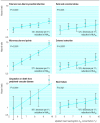Association of glycaemia with macrovascular and microvascular complications of type 2 diabetes (UKPDS 35): prospective observational study
- PMID: 10938048
- PMCID: PMC27454
- DOI: 10.1136/bmj.321.7258.405
Association of glycaemia with macrovascular and microvascular complications of type 2 diabetes (UKPDS 35): prospective observational study
Abstract
Objective: To determine the relation between exposure to glycaemia over time and the risk of macrovascular or microvascular complications in patients with type 2 diabetes.
Design: Prospective observational study.
Setting: 23 hospital based clinics in England, Scotland, and Northern Ireland.
Participants: 4585 white, Asian Indian, and Afro-Caribbean UKPDS patients, whether randomised or not to treatment, were included in analyses of incidence; of these, 3642 were included in analyses of relative risk.
Outcome measures: Primary predefined aggregate clinical outcomes: any end point or deaths related to diabetes and all cause mortality. Secondary aggregate outcomes: myocardial infarction, stroke, amputation (including death from peripheral vascular disease), and microvascular disease (predominantly retinal photo-coagulation). Single end points: non-fatal heart failure and cataract extraction. Risk reduction associated with a 1% reduction in updated mean HbA(1c) adjusted for possible confounders at diagnosis of diabetes.
Results: The incidence of clinical complications was significantly associated with glycaemia. Each 1% reduction in updated mean HbA(1c) was associated with reductions in risk of 21% for any end point related to diabetes (95% confidence interval 17% to 24%, P<0.0001), 21% for deaths related to diabetes (15% to 27%, P<0.0001), 14% for myocardial infarction (8% to 21%, P<0.0001), and 37% for microvascular complications (33% to 41%, P<0.0001). No threshold of risk was observed for any end point.
Conclusions: In patients with type 2 diabetes the risk of diabetic complications was strongly associated with previous hyperglycaemia. Any reduction in HbA(1c) is likely to reduce the risk of complications, with the lowest risk being in those with HbA(1c) values in the normal range (<6.0%).
Figures




Comment in
-
Controlling glucose and blood pressure in type 2 diabetes.BMJ. 2000 Aug 12;321(7258):394-5. doi: 10.1136/bmj.321.7258.394. BMJ. 2000. PMID: 10938030 Free PMC article. No abstract available.
-
Glycaemia and vascular effects of type 2 diabetes. Lowering glucose concentrations may not be of any value in itself.BMJ. 2001 May 19;322(7296):1245-6; author reply 1247. BMJ. 2001. PMID: 11388182 Free PMC article. No abstract available.
-
Glycaemia and vascular effects of type 2 diabetes. Relation between diabetes and hyperglycaemia and cardiovascular disease has not been resolved.BMJ. 2001 May 19;322(7296):1246-7. BMJ. 2001. PMID: 11388183 No abstract available.
-
Glycaemia and vascular effects of type 2 diabetes. UKPDS is not a cohort study and analysis is misleading.BMJ. 2001 May 19;322(7296):1246; author reply 1247. BMJ. 2001. PMID: 11388184 No abstract available.
-
Very tight glucose control: May be high risk, low benefit.BMJ. 2008 Mar 29;336(7646):683. doi: 10.1136/bmj.39520.531319.3A. BMJ. 2008. PMID: 18369208 Free PMC article. No abstract available.
References
-
- UKPDS Group. Intensive blood glucose control with sulphonylureas or insulin compared with conventional treatment and risk of complications in patients with type 2 diabetes (UKPDS 33) Lancet. 1998;352:837–853. - PubMed
-
- Klein R. Hyperglycemia and microvascular and macrovascular disease in diabetes. Diabetes Care. 1995;18:258–268. - PubMed
-
- Pirart J. Diabetes mellitus and its degenerative complications: a prospective study of 4,400 patients observed between 1947 and 1973 (part 1) Diabetes Care. 1978;1:168–188.
-
- Adler AI, Boyko EJ, Ahroni AJ, Stensel V, Forsberg RC, Smith DG. Risk factors for diabetic peripheral sensory neuropathy. Results of the Seattle prospective diabetic foot study. Diabetes Care. 1997;20:1162–1167. - PubMed
Publication types
MeSH terms
Substances
LinkOut - more resources
Full Text Sources
Other Literature Sources
Medical
Miscellaneous
